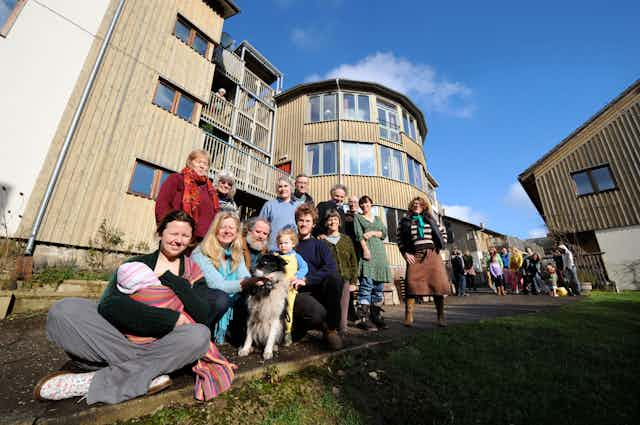People have sought solace and strength in communal living for thousands of years. But unlike traditional villages bound by kinship or geography, “intentional communities” are deliberately constructed by people who choose to share not just space, but also a specific set of values, beliefs or goals. Such forging of a collective path is often in response to times of social change.
Here are three instances where people have turned to intentional communities to seek sanctuary, purpose and alternative ways of living.
Second world war
As the war raged across Europe, one particular group of people was looking for alternative solutions. Conscientious objectors were people who refused to fight for moral or religious reasons.
It is estimated that there were around 60,000 male conscientious objectors in Britain. Some took up non-combatant roles, such as medics, but others sought out less conventional opportunities. With farming identified as an exempt occupation, some conscientious objectors joined pacifist “back to the land” communities.
One such community was Frating Hall Farm in Essex. It provided a safe haven for those who did not wish to fight in the war. As well as farming, the community lived, ate and worked together.
Another such community was Collow Abbey Farm in Lincolnshire. This was a farming cooperative set up by a different set of conscientious objectors. Again, the principles of pacifism, farming and community brought individuals and families together in a time of need.
Many of these communities dissipated after the war ended, having served their purpose as safe havens for pacifists.
1960s
Still in the shadow of the second world war, the 1960s blossomed into a more permissive era which allowed for a freer sense of self and expression. This decade heralded a sense of social change with movements such as civil rights and women’s rights emerging. As the decade progressed, so did the different types of intentional communities.
The 1960s commune movement has been described by some experts as a hotbed of free love, drug taking and loose morals. But others argue they embodied something much more important and were representative of the social changes under way at the time.
In an attempt to escape “straight” society, many young people sought out spaces that allowed them to experiment with alternative forms of living and identity. These were communities that often embraced the non-nuclear family alongside other “counter cultural” ideas such as veganism and non-gendered childrearing.
One well documented example of this is Braziers Park in Oxfordshire. It was a community that formed in the 1950s but flourished in the 1960s and 70s. Braziers was initially set up as an educational community.
Its alternative nature attracted the likes of Rolling Stones frontman, Mick Jagger, and his then girlfriend Marianne Faithfull, who had lived there during her early life. She described it as “otherworldly” in her memoir. Braziers still exists today and now offers courses, workshops and retreats.
Read more: Four reasons to consider co-housing and housing cooperatives for alternative living
Another example was Crow Hall in Norfolk, which was founded in 1965. Although they denied they were a commune, it had all of the marks of being one, with elements such as shared accommodation and collective child rearing. The community operated an open door policy, inviting others to “come find themselves”. It eventually dispersed in 1997.
Like Braziers, some communities set up during the 1960s are still in place today such as Postlip Hall near Cheltenham, or the Ashram Community near Sheffield. But many others ended as society moved on. Experts who have reflected on this period describe it as both a time of freedom and, for others, mistakenly liberal.
Today
The communities scene continues to flourish but this time under new challenges such as an ageing population and climate change. It’s difficult to estimate how many such communities exist in the UK, as nobody keeps official figures.
Arguably, some of the same generation who were “tuning in and dropping out” in the 1960s are now seeking equally alternative solutions for their older age. For some, this is to be found in the phenomenon of “senior cohousing”. These are intentional communities run by their residents where each household is a self-contained home alongside shared community space and facilities.
One example of senior cohousing is New Ground in north London. This is a community of older women, founded in 1998, who took their housing situation into their own hands. Defying some of the more traditional models of housing for older people, such as sheltered accommodation, New Ground is an intentional community for women over 50. They live by the ethos of “looking out for, rather than looking after each other”.
For others, the solution involves joining an intergenerational community such as Old Hall in Suffolk where octogenarians live alongside children and adults under one roof. This is a community of around 50 people who farm the land, share their meals and manage the manor house in which they live.
As society evolves, so too do the forms that intentional communities take. While the specific challenges may change, the human desire for connection and a sense of belonging remains constant.

